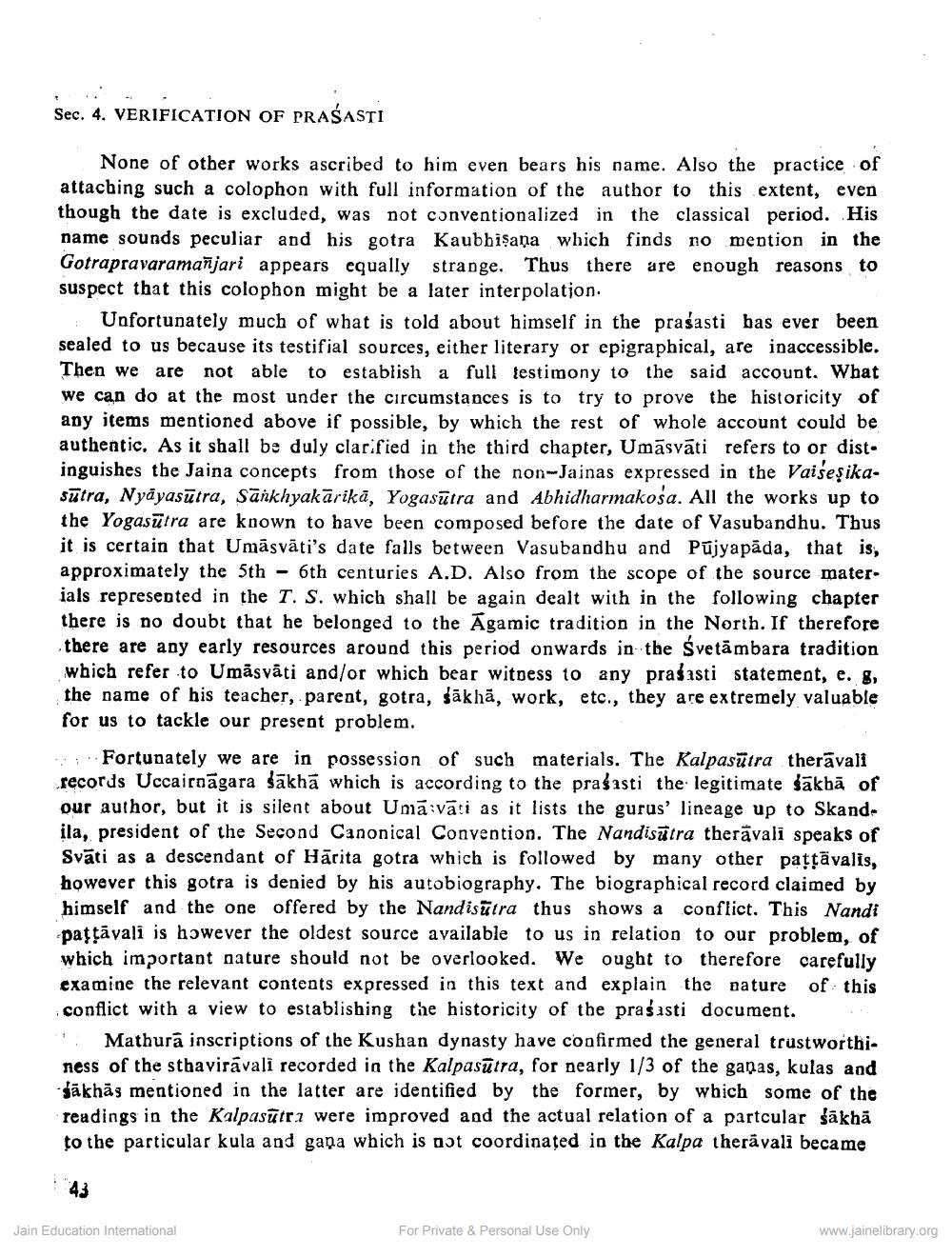________________
Sec. 4. VERIFICATION OF PRASASTI
None of other works ascribed to him even bears his name. Also the practice of attaching such a colophon with full information of the author to this extent, even though the date is excluded, was not conventionalized in the classical period. His name sounds peculiar and his gotra Kaubbişana which finds no mention in the Gotrapravaramañjari appears equally strange. Thus there are enough reasons to suspect that this colophon might be a later interpolation.
Unfortunately much of what is told about himself in the prasasti has ever been sealed to us because its testifial sources, either literary or epigraphical, are inaccessible. Then we are not able to establish a full testimony to the said account. What we can do at the most under the circumstances is to try to prove the historicity of any items mentioned above if possible, by which the rest of whole account could be authentic. As it shall be duly clarified in the third chapter, Umāsvāti refers to or dist. inguishes the Jaina concepts from those of the non-Jainas expressed in the VaiseşikaSūtra, Nyāyasūtra, Sankhyakārikā, Yogasūtra and Abhidharmakosa. All the works up to the Yogasūtra are known to have been composed before the date of Vasubandhu. Thus it is certain that Umāsvāti's date falls between Vasubandhu and Pujyapāda, that is, approximately the 5th - 6th centuries A.D. Also from the scope of the source materials represented in the T. S. which shall be again dealt with in the following chapter there is no doubt that he belonged to the Āgamic tradition in the North. If therefore there are any early resources around this period onwards in the Svetāmbara tradition which refer to Umāsvāti and/or which bear witpess to any prašasti statement, e. g, the name of his teacher, parent, gotra, sākhā, work, etc., they are extremely valuable for us to tackle our present problem.
Fortunately we are in possession of such materials. The Kalpasūtra therāvali records Uccairoāgara sākhā which is according to the prasasti the legitimate sākhā of our author, but it is silent about Umā vāti as it lists the gurus' lineage up to Skandila, president of the Second Canonical Convention. The Nandisātra therävali speaks of Svāti as a descendant of Hārita gotra which is followed by many other pattāvalis, however this gotra is denied by his autobiography. The biographical record claimed by himself and the one offered by the Nandisātra thus shows a conflict. This Nandi paţtāvali is however the oldest source available to us in relation to our problem, of which important nature should not be overlooked. We ought to therefore carefully examine the relevant contents expressed in this text and explain the nature of this conflict with a view to establishing the historicity of the prasasti document. ' Mathura inscriptions of the Kushan dynasty have confirmed the general trustworthiness of the sthaviravali recorded in the Kalpasūtra, for nearly 1/3 of the ganas, kulas and sākhās mentioned in the latter are identified by the former, by which some of the readings in the Kalpasūtrz were improved and the actual relation of a partcular šākhā to the particular kula and gana which is not coordinated in the Kalpa therāvali became
Jain Education International
For Private & Personal Use Only
www.jainelibrary.org




